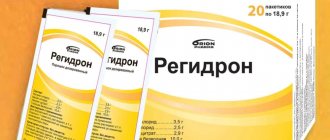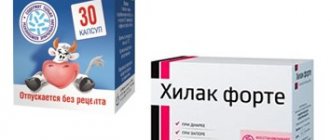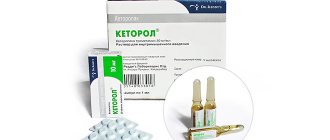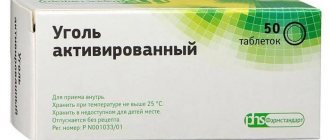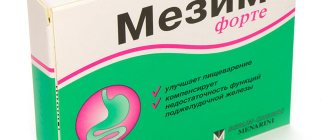Foodborne toxic infection is caused by the action of a toxin that is released by a pathogenic pathogen upon penetration into the body. Poisoning with low-quality products leads to dehydration of varying degrees of severity. In case of food poisoning, a dropper normalizes water and electrolyte balance, increases urine volume, thereby accelerating the removal of toxins from the body, and restores blood acidity levels.
Indications for placing an IV include repeated vomiting and profuse diarrhea, voluntary or forced refusal to take fluids, acidosis (increased acidity), a violation of the quantitative ratio of sodium, chlorine, and potassium ions.
Absolute contraindications for drips are acute heart failure (cardiac asthma, cardiogenic shock), anuria (lack of urine), pulmonary edema.
Glucose release form and price
Glucose is available as a 5% or 10% solution for infusion.
Composition of 1 liter of solution:
| Dehydrated glucose | Water for injections | |
| 5% solution | 50 g | 1 l |
| 10% solution | 100 g |
Glucose can also be included in solutions containing additional active components. Such means include:
- Actovegin with glucose;
- Plasma-lit 148;
- Dianil PD4;
- glycated ascorbic acid.
Plasma-lit 148 is one of the most popular solutions with glucose
The cost of glucose solution depends on the manufacturer, city and specific pharmacy. The average price ranges from 20-700 rubles.
Digestion process
Glucose drops for food poisoning
The main source of glucose entering the body is food. Cells are not able to synthesize simple carbohydrates on their own, so regular nutrition is necessary to maintain blood sugar levels.
Liver cells are capable of storing a small amount of carbohydrates in the form of glycogen, but during fasting this reserve lasts for several days.
The process of glucose intake and absorption begins in the gastrointestinal tract. The action of special enzymes ensures the breakdown of primary substrates and the release of simple components, including glucose, fructose, galactose and other monosaccharides.
These chemicals enter the blood vessels through the walls of the small intestine and are transported to the liver. The absorption of carbohydrates is a complex process regulated by pancreatic hormones.
Glucose entering the blood must enter the cells for storage or use. The body also needs to regulate sugar levels during other periods when food substrates are not supplied from the outside.
Sometimes, to meet the energy needs of cells, it is necessary to consume internal carbohydrate reserves. Main types of regulation:
- Insulin is a hormone of the endocrine pancreas that enters the blood after eating. The interaction of this substance with cell receptors ensures the absorption of sugar and a decrease in the concentration of glucose in the blood.
- Glucagon is a pancreatic hormone that triggers the breakdown of liver glycogen. The action of this chemical compound leads to an increase in the concentration of sugar in the blood, which may be necessary during fasting.
- Gluconeogenesis is the conversion of non-carbohydrate substances into glucose in the liver.
The listed processes ensure a constant content of 3.3-5.5 mmol of glucose per liter of blood. This concentration is sufficient to meet the energy needs of all cells in the body.
How is glucose useful for the human body?
In medicine, there are 2 types of solutions: isotonic and hypertonic. They differ in the concentration of glucose in the liquid, as well as in the positive effects they have on the body.
Isotonic solution
A 5% solution with water for injection or saline is called isotonic. It demonstrates the following beneficial properties:
- replenishes fluid reserves in the body;
- nourishes the body's cells with useful substances;
- stimulates brain function, improves blood circulation;
- removes toxins and waste from the body.
Isotonic glucose solution stimulates brain function
An isotonic solution is injected into the body subcutaneously, into a vein, and as an enema.
Hypertonic solution
Hypertonic solution is a 10-40% aqueous solution for intravenous administration. It has a positive effect on the body:
- promotes the expansion and strengthening of blood vessels;
- stimulates the production and excretion of more urine;
- accelerates metabolic processes in the body;
- improves the functioning of the liver and heart muscle;
- increases the outflow of fluid from tissues into the blood;
- normalizes blood osmotic pressure;
- removes waste and toxins of various origins from the body.
Hypertonic solution removes various toxins from the body
To enhance the beneficial properties of glucose, it is often combined with other active ingredients.
Preventing dehydration
How to prevent dehydration? Below are effective tips from doctors to protect against dehydration:
- avoid physical activity in hot weather;
- take time to relax in a cool place;
- carry a bottle of water in your bag;
- do not abuse alcohol;
- do not eat a lot of sugar and sweets;
- wear only breathable clothes made from natural fabrics;
- When performing physical activity, consume special drinks that contain electrolytes.
By carefully following all these recommendations, you will always feel cheerful, healthy and full of energy!
Indications for the use of intravenous glucose
Intravenous administration of glucose solution is prescribed to improve the condition of the human body for the following indications:
- dehydration of cells and the body as a whole;
- extracellular hyperhydration;
- hypoglycemia in the acute stage;
- liver diseases: hepatitis, cirrhosis, hepatic coma;
- severe infectious diseases;
- a sharp decrease in blood pressure - collapse, shock;
- insufficient volume of diuresis, especially after operations;
- cardiac decompensation;
- hemorrhagic diathesis;
- internal bleeding;
- lung pathologies: edema, fluid accumulation;
- intoxication of the body: alcohol, drugs, medications.
Glucose administration is prescribed for the treatment of various lung pathologies.
Solutions with the addition of additional active components are used in the following cases:
- With ascorbic acid: for bleeding, for infectious diseases, for fever, for Addison's disease and nephropathy of pregnancy, for increased mental and physical stress, for an overdose of anticoagulants, for vitamin deficiency and hypovitaminosis with a lack of vitamin C.
- With novocaine: for poisoning of various origins, for post-transfusion complications, for gestosis during pregnancy with edema, toxicosis and convulsions.
- With sodium chloride: for a lack of sodium in the body, for the correction of hyponatremia in pathologies of the kidneys and adrenal glands, to maintain the volume of extracellular fluid during operations.
- With potassium chloride: for hypokalemia due to intoxication, increased diathesis and diabetes mellitus, for digitalis intoxication, for the prevention of arrhythmia in acute myocardial infarction.
- Actovegin: during pregnancy, for ulcers and bedsores, for burns and wounds of varying degrees, for vascular disorders in the brain, arteries and veins.
- Dianil PD4: for acute and chronic renal failure, for intoxication of the body, for excess fluid and electrolyte imbalance.
- Plasma-lit 148: for dehydration as a result of increased diathesis, poisoning, burns, peritonitis and intestinal obstruction.
Important!
Also, a 5% isotonic glucose solution can be used to dilute medications administered intravenously in the form of injections and infusions.
For newborns
For infants, a glycated solution is indicated for the following conditions:
- lack of mother's milk;
- hypoglycemia of newborns;
- birth injuries, prematurity;
- oxygen starvation, dehydration;
- poisoning of the body with toxins;
- jaundice of various origins.
Glucose solution is used to treat jaundice in newborns
The dosage for an IV for a newborn should not exceed 5%. The solution is administered perinatally.
Basic information about the medicine
Glucose is a simple carbohydrate that is the main source of energy in the body. This chemical compound ensures all metabolic processes in the cells of the body, so a person needs a constant supply of sugar from food.
A blood test for sugar (glucose) is also a universal indicator of the condition of cells and organs, since a constant concentration of this carbohydrate in the plasma is required to perform vital functions.
Glucose is found in some amount in almost all food products. This can be regular sugar or complex carbohydrates, which are broken down into glucose and other monosaccharides in the digestive organs.
Simple sugars are found in large quantities in various fruits and sweets, and complex carbohydrates are found in vegetables, cereals, nuts and other plant products. Nutritionists recommend preparing your diet in such a way that foods contain simple and complex sugars.
The main functions of the substance in the body:
- Formation of energy substrates in cells necessary to maintain metabolism. Even a slight deficiency of glucose in the blood can cause dysfunction of the central nervous system.
- Regulation of osmotic pressure in the blood.
- Maintaining the functions of the kidneys, liver and cardiovascular system.
Glucose is also a common medicine necessary to restore the constancy of the body's internal environment. Conditions such as hypoglycemia, dehydration and blood loss may require intravenous infusion of a sugar solution.
It is important to understand that excess or lack of blood glucose has an extremely negative effect on the functioning of internal organs. Hypoglycemia and hyperglycemia can even cause death.
Possible harm from glucose
The use of glucose can have a negative effect on the human body:
- weight gain, increased appetite;
- disturbance of ionic, water and electrolyte balance;
- increased temperature, fever;
- blood clots at injection sites;
- osmotic diuresis with loss of water and electrolytes;
- increasing blood volume in the body;
- hyperglycemic attack, hyperosmolar coma;
- acute left ventricular failure;
- pathologies of the liver and pancreas;
- coma, shock.
To avoid side effects, an IV is placed only as prescribed by a doctor and if there are certain indications for use.
Eating while vomiting
The correct answer is nothing. If a child is vomiting, then it is advisable not to feed him until he asks or until 8 hours have passed without vomiting . An exception is breastfed babies: they need to be offered the breast every two hours, but feed for no more than 5-10 minutes so that the baby receives only liquid upper milk.
The girl refuses to eat
For children who already eat adult food, after 8 hours without vomiting, you can try giving cereal porridge without milk, but only a little. You can try other solid foods: for example, biscuits or crackers. The jelly should not damage either, as it gently envelops the walls of the stomach and helps them recover faster.
The first days after the end of vomiting, you need to stick to a diet and do not immediately jump on too spicy, fried, smoked and other not very healthy dishes.
Some doctors recommend even longer abstinence from food after vomiting. According to these recommendations, at least 13 hours should pass from the last attack of vomiting to the first meal.
Algorithm for preparing a glucose drink
How to properly prepare a drink that will help with poisoning? At home, it is not necessary to have medicinal powder. The medicinal drink is quite simple to prepare.
- Take hot or warm water in the amount of two hundred milliliters.
- Add up to three tablespoons of sugar and mix thoroughly.
- The finished drink is given to small children warm; they should drink in small sips.
- It is allowed to replace the solution with compote, sweet tea, fruit drink - in addition to glucose, they contain many vitamins that are also beneficial for the child’s body.
As you can see, preparing a healthy drink is easy. At home, such an action will not take much time. The use of a solution for intravenous administration is permissible only in a medical institution under the supervision of a medical professional.
What is included in a biochemical blood test and what does it show?
The first examination that is prescribed for any disease is a biochemical blood test.
The use of this popular diagnostic method makes it possible to detect pathological processes developing in the body.
What does a biochemical blood test show?
There are advanced and general therapeutic standards of biochemical analysis. The general therapeutic standard includes the study of basic indicators of human blood components, which can reveal disorders occurring in the heart, urinary, endocrine or digestive systems, and the presence of inflammation in the liver tissue.
The main indicators include:
- total protein;
- aspartate aminotransferase (AST);
- alanine aminotransferase (ALT);
- direct and total bilirubin;
- urea;
- glucose;
- cholesterol;
- creatinine;
- electrolytes.
The advanced analysis tests additional enzymes necessary to clarify the diagnosis:
- c-reactive protein;
- globulins;
- ferritin;
- fructosamine;
- lipoproteins;
- vitamins;
- microelements.
Indications for donating blood from a vein
It is worth deciphering the results of the biochemistry analysis and the specialist will see a complete picture of the state and functioning of all internal organs and systems in the body.
Therefore, a biochemical study is carried out in the following cases:
- during annual preventive examinations;
- during pregnancy;
- to monitor the effectiveness of therapy;
- if there are symptoms of dysfunction of any organs.
How to donate blood for biochemistry?
To get a reliable result, before taking blood for biochemistry, you must follow several rules:
- Before the study, it is forbidden to eat or smoke;
- the day before the analysis, avoid the consumption of sweets, strong tea and coffee;
- It is not recommended to visit the bathhouse the day before donating blood and subject yourself to intense physical activity;
- two days before the upcoming analysis, give up alcoholic and carbonated drinks;
- within two weeks before the study, it is advisable to stop taking the complex of vitamins and medications.
Blood is donated in the morning. 5 to 10 ml of blood is taken from a vein located in the bend of the elbow.
The collected blood samples are transported to the laboratory in a closed container, protected from light to prevent the destruction of bilirubin.
If there is a need to retake the test, then you need to donate blood at the same time and in the same laboratory as the previous one.
What does biochemical analysis include?
Biochemical analysis reflects the quantitative content of significant blood components:
- sugar level is an indicator of proper carbohydrate metabolism and depends on the activity of the endocrine system;
- liver tests establish the concentration of major liver enzymes. The coefficients of AST, ALT, GTTP, alkaline phosphatase and bilirubin help determine the condition and degree of functioning of the gland;
- protein and its fractions are responsible for the distribution of useful substances throughout the body and are involved in the production of new cells and immunity;
- urea, uric acid and creatinine, are formed in the liver due to the breakdown of spent cells and are excreted by the urinary system;
- lipids and cholesterol take an active part in the production of bile, hormones and new tissues, contribute to energy production;
- the content of potassium in the blood reflects the condition of the heart and blood vessels;
- sodium affects acidity levels and osmotic pressure.
Analysis transcript
Only a doctor can read the test result correctly, taking into account the patient’s age and gender. The specialist will detect signs of the disease in the form of a significant deviation from the table indicators.
You can get a general impression of your health on your own if you know the acceptable level of each enzyme.
Normal indicators
A table has been developed containing a list of acceptable standards for the concentration of individual blood components in the studied samples.
To decipher the study of blood biochemistry, a comparison of the indicators of each blood sample with the index of norms is used.
Table of normal blood values:
Blood chemistry
| Indicators | Children | Adults | |||||
| up to 1 month | up to 12 months | 1-14 years | men | women | |||
| Total protein (g/l) | 46-68 | 56-73 | 63-82 | 68-83 | |||
| Albumin (g/l) | 35-44 | 35-49 | 36-55 | 25-40 | |||
| Aspartate aminotransferase AST (units/l) | 30-75 | 15-51 | Up to 47 | Up to 41 | |||
| Alanine aminotransferase ALT (units/l) | 13-60 | 12-60 | Up to 55 | Up to 43 | |||
| Phosphotase alkaline (units/l) | Up to 180 | Up to 650 | 35-130 | ||||
| Cholesterol (mmol/l) | 1,5-5 | 2,1-4,5 | 3,1-7,4 | From 3 to 7 | |||
| HDL (mmol/l) | 1-3,9 | More than 1.2 | More than 1.5 | ||||
| LDL (mmol/l) | 2,6-4,5 | 2,5-4,7 | Less than 3 | ||||
| Glucose (mmol/l) | 2,7-4,6 | 3,4-7,2 | 3,5-7,3 | ||||
| Direct bilirubin (µmol/l) | 4-13,7 | 0,8-4,3 | 0,3-4,2 | ||||
| Total bilirubin (µmol/l) | 10-51 | 4,5-22,5 | 3-17,5 | ||||
| Folic acid (ng/ml) | 3,27 | 3-17,5 | |||||
| Vitamin B 12 (ng/l) | 161-1300 | 182-910 | |||||
| Iron (µmol/l) | 9,6-43 | 5,3-15 | 9,3-30 | 12,6-32 | 8,8-31,4 | ||
| Potassium (mmol/l) | 3,7-7,5 | 3-6,6 | 2,9-6,4 | 2,4-6,5 | |||
| Sodium (mmol/l) | 126-156 | 122-150 | 132-165 | 126-145 | |||
| Phosphorus (mmol/l) | 1,1-3,9 | 1,3-2,8 | 1-2,7 | 0,88-1,53 | |||
| Calcium (mmol/l) | 0,92-1,26 | 1,04-2,2 | 2,24-3,5 | ||||
| Magnesium (mmol/l) | 0,67-2,75 | 0,7-2,3 | 0,6-1,14 | ||||
| Creatinine (µmol/l) | 35-130 | 57-125 | 45-87 | ||||
| Urea (mmol/l) | 1,5-6,4 | 3,4-7,5 | 2,4-8,2 | 2,19-6,49 | |||
| Uric acid (µmol/l) | 0,15-0,45 | 0,23-0,36 | 0,2-0,43 | 210-319 | 146-349 | ||
What not to do
You need to be aware that the use of glucose is not always permitted. Before starting treatment, it is necessary to exclude some contraindications.
- Constantly elevated blood sugar.
- Reduced glucose tolerance.
- Allergic reactions to the substance.
- Heart failure in acute and chronic form.
- Renal failure in the chronic stage.
- Edema syndrome.
- Hyperglycemia.
- Hyperosmolar coma.
- Elevated levels of sodium in the body.
- High levels of lactic acid in the blood in the presence of diabetes.
It is permissible to use glucose in pregnant women and during lactation, but under medical supervision.
In case of poisoning in children, glucose is a necessary substance, but it is permissible to consume it only in the form of drinks. The substance in tablets, sweets and chocolate are prohibited. All products containing glucose have an irritating effect on the weakened mucous membrane of the child’s stomach, so they must be abandoned.
Side effects
Intravenous glucose infusion must be supervised by a healthcare professional!
As with the use of other medications, the administration of a glucose solution can cause the development of negative symptoms. This is usually due to individual intolerance of the body or incorrect dosage of components.
Possible adverse reactions:
- Redness and swelling of the skin at the injection site.
- Dizziness.
- Nausea and vomiting.
- Swelling in the lower extremities.
- Heart rhythm disorder.
- Sweating, pale skin.
- Hyperglycemic coma.
If such symptoms appear during intravenous administration of the drug, you should consult a doctor. Side effects may be associated with dangerous conditions such as hyperglycemia and allergic reactions.
Thus, isotonic and hypertonic solutions of simple carbohydrates can be prescribed for various pathologies. To understand why glucose is dripped, you need to have an idea of the composition of the blood and the vital functions of the body.
This video will show you how to provide help for food poisoning:
Noticed a mistake? Select it and press Ctrl+Enter to let us know.
Glucose is a powerful and effective source of nutrition for the human body, absorbed in the shortest possible time. The level of monosaccharide in the blood depends on the age and condition of the person. Glucose is administered intravenously to restore metabolic processes, cleanse toxins and restore performance.
Glucose is given intravenously as an effective source of nutrition
Droppers
The isotonic solution is administered subcutaneously from 300 to 500 ml. Administration through enemas or drips (intravenously) is also possible. In this case, the patient should receive about 2 liters per day. solution. A five percent isotonic dextrose solution is injected using a dropper into a vein or under the skin or rectum in case of severe blood loss, dehydration or shock. In this case, you need to administer from 300-400 ml to a liter or two in 24 hours. If the solution is five percent, an instillation rate of up to 7 ml is suitable. per minute, if ten percent, the speed should be three milliliters per minute.
pharmachologic effect
First of all, the monosaccharide described is a natural storehouse of energy. Preparations containing it are often prescribed for diseases accompanied by depletion of the body. Due to the injected solution, blood volume increases, liver functions are activated, helping to naturally neutralize toxic substances, and urine excretion is also stimulated, which also helps eliminate toxins.
The mechanism of action of the active substance of the drug is the phosphorylation of glucose (transformation into Robison's ester) upon entry into tissues, and then in the substrate inclusion of energy (glycolysis - the breakdown of a molecule with the release of a significant amount of energy) and plastic (lipolysis - the breakdown of fats into fatty acids, transamination – reaction of transfer of an amino group from an amino acid to a keto acid, synthesis of nucleotides) metabolism.
Glucose is compatible with other drugs; moreover, it is often dripped into a vein in combination with something else to increase efficiency and more targeted treatment. Such combinations are often used in medicine.
- Glucose with ascorbic acid (AA) is used for large blood losses and to eliminate infections. This compound can support health and immunity during severe stress, and since AK contains a lot of vitamin C, doctors use this combination against vitamin deficiencies.
- Glucose with novocaine is prescribed for poisoning with various substances (from alcohol to other medications) and toxicosis, as well as for the prevention of pathologies that can develop after blood transfusion. This is very important because post-transfusion complications are deadly.
- Glucose and sodium chloride are used to normalize the volume of extracellular fluid during surgical operations. This solution can also replenish sodium deficiency.
- Combination with potassium chloride helps prevent arrhythmia during myocardial infarction, as well as restore potassium balance after intoxication.
Although such mixtures have been used for a long time, their discussions in professional circles do not stop even now. Already several years ago, there were active suggestions that if a myocardial infarction occurred, then such a mixture could have a positive effect in various directions at once, in particular:
- stabilize heart rate by improving the metabolism of the affected areas;
- have a beneficial effect by increasing the total volume of potassium content inside myocardial cells.
Insulin also plays an important role, which is responsible for the deposition of potassium and glucose in cells. Even if there is no additional supply of glucose, calcium accumulates in the cell, which allows normalization of polarization processes in myocardial tissue. And if glucose also comes in, then everything is absolutely wonderful.
